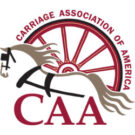
A Broad Outline of an AIAT Event
The ambition and objective of the A.I.A.T (Association Internationale d’Attelage de Tradition) is to promote and encourage the use of traditional carriages plus the skills and traditions of driving those carriages in a competent and pleasurable manner. The AIAT was founded in 2008 by Baron Christian de Langlade, who is the President of the Association. The Carriage Association of America is the representative organization of the AIAT in the United States.
A C.I.A.T event (Concours Internationale d’Attelage de Tradition) consists of three phases – Presentation, The Routier (a road drive), and Maniabilité (cones driving) and encompassing other enjoyable social activities in a friendly, relaxed, and sporting style. The event is held at beautiful country locations with over 60 events in 14 countries annually.
The Carriage
A well maintained *traditional carriage (private or trade/commercial) put to a single, pair, tandem or team, drawn by a pony, horse, donkey, or heavy horse, turned out in the nation’s or region’s traditional style, but not fancy dress. Carriages built before 1945 (declared on the entry-form) have a slight advantage in Presentation over those built after 1945.
*The AIAT Definition for a traditional equipage: For the purposes of traditional carriage driving activities a traditional coach, private driving, or light trade vehicle, agricultural wagon or dray is a vehicle of an identifiable type and profile that resembles the design and construction of a carriage-builder before the early 20th century. The vehicle shall be constructed from traditional materials with appropriate traditional-style springing, trimmings and accessories, including lamps. The harness used to be preferably a full-collar leather set.
The Equine
A well-mannered equine of any breed, have a current vaccination certificate and Coggins per event guidelines, be appropriately shod and fit enough to complete a 12 to 17km (7-10 mile) drive including Performance Challenges (obstacles) at an appropriate speed depending on their height.
The Owner/Whip/Coachman
The owner/whip/coachman must be at least 12 years old. Young whips between 12-16 years old must be accompanied by a competent adult.
Officials
The panel of officials consists of a President of the Jury, plus two or three AIAT-listed judges supported by a Technical Delegate.
Presentation Judging
The judging of the standing Presentation phase is done by the 3 judges individually assessing each equipage, at 3 judging stations. Individual turnouts are judged at allocated time slots in three separate locations by AIAT Approved judges.
You will be closely inspected by the individual judge where you will be scored for overall impression, the condition of the horse, the carriage, the harness, and the passengers. You will be expected to present a turnout that is correct as possible for your equipage including fitting of harness, appropriate carriage, fit, and passenger’s attire.
Scores are taken on an official AIAT score sheet. all competitors will be issued with a copy after the competition has finished. Please note, this presentation sheet cannot be copied and used for any other event other than a bona fide AIAT competition.
The Routier
The Routier is a test of rein handling skills and judge of pace using minor country roads, estate drives and good tracks, at a set speed based on the height of the equine and following the marked route. An unhorsed tour of the course is usually arranged ahead of the drive. In addition, five natural-style or purpose-built Performance Challenges (obstacles) are included along the route with penalties if not driven satisfactorily. These will be selected by the event organizer from an approved selection in accordance with AIAT regulations. Competitors will be expected to negotiate these Performance Challenges (PC’s) with penalty points awarded for failure to negotiate, failure to undertake the PC correctly, or no penalties for undertaking the PC correctly.
The Maniabilité
The final stage of the event is where competitors will be expected to negotiate a series of cones (Maniabilité) with balls mounted to determine if you hit the cone. This stage of the event is to test the driver’s precision skills. The cones course is expected to be driven in a gently flowing manner against an optimum time. Cone widths are changed to suit the width of the individual competitor’s carriage, varying from narrow Donkey carts to wider Road Coaches. Depending on prevailing conditions, the number of cones will be set by the individual event organiser, but is normally around 20 gates. Penalties will be issued for balls down and time penalties for times under or over the allocated time. On completion of the cones course the competitor’s scores are gathered, calculated, and tabulated to determine the individual category winner.
After a short break to allow for the scorekeepers to update their records, all competitors are expected to return for the gala parade and prize giving.
Whips are allowed to walk the course at a prescribed time ahead of the competition.
Scoring and Prize Giving
Individual scores are not published during the event and are announced at the prize giving. All the participants assemble in the ring and the winners are then called forward class by class for the presentation of ribbons, etc. Individual score sheets are then made available.

You must be logged in to post a comment.